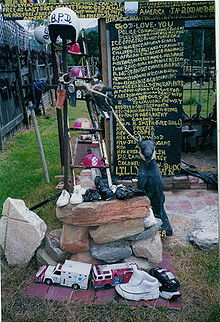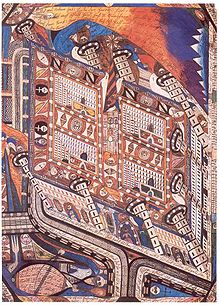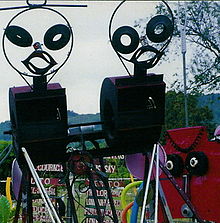- Outsider art
-
"Art brut" redirects here. For the band, see Art Brut (band).
The term outsider art was coined by art critic Roger Cardinal in 1972 as an English synonym for art brut (French: [aʁ bʁyt], "raw art" or "rough art"), a label created by French artist Jean Dubuffet to describe art created outside the boundaries of official culture; Dubuffet focused particularly on art by insane-asylum inmates.[1]
While Dubuffet's term is quite specific, the English term "outsider art" is often applied more broadly, to include certain self-taught or Naïve art makers who were never institutionalized. Typically, those labeled as outsider artists have little or no contact with the mainstream art world or art institutions. In many cases, their work is discovered only after their deaths. Often, outsider art illustrates extreme mental states, unconventional ideas, or elaborate fantasy worlds.
Outsider art has emerged as a successful art marketing category (an annual Outsider Art Fair has taken place in New York since 1993). The term is sometimes misapplied as a catch-all marketing label for art created by people outside the mainstream "art world," regardless of their circumstances or the content of their work.
Contents
Art of the insane
Interest in the art of insane asylum inmates had begun to grow in the 1920s. In 1921 Dr. Walter Morgenthaler published his book Ein Geisteskranker als Künstler (A Psychiatric Patient as Artist) on Adolf Wölfli, a psychotic mental patient in his care. Wölfli had spontaneously taken up drawing, and this activity seemed to calm him. His most outstanding work is an illustrated epic of 45 volumes in which he narrates his own imaginary life story. With 25,000 pages, 1,600 illustrations, and 1,500 collages, it is a monumental work. He also produced a large number of smaller works, some of which were sold or given as gifts. His work is on display at the Adolf Wölfli Foundation in the Museum of Fine Art, Bern. A defining moment was the publication of Bildnerei der Geisteskranken (Artistry of the mentally ill) in 1922, by Dr Hans Prinzhorn.
People with some artistic training and well-established artists are not immune from mental illness and may also be institutionalised. For example, William Kurelek, later awarded the Order of Canada for his artistic life work, as a young man was admitted to the Maudsley Psychiatric Hospital where he was treated for schizophrenia.[2] In hospital he painted, producing "The Maze", a dark depiction of his tortured youth.[3] This 1953 work was used as the cover of the 1981 Van Halen rock album Fair Warning. His experience in the hospital was documented in the LIFE Science Library book The Mind, published in 1965.
Jean Dubuffet and art brut
French artist Jean Dubuffet was particularly struck by Bildnerei der Geisteskranken and began his own collection of such art, which he called art brut or raw art. In 1948 he formed the Compagnie de l'Art Brut along with other artists, including André Breton. The collection he established became known as the Collection de l'Art Brut. It contains thousands of works and is now permanently housed in Lausanne, Switzerland.
Dubuffet characterized art brut as:
- "Those works created from solitude and from pure and authentic creative impulses – where the worries of competition, acclaim and social promotion do not interfere – are, because of these very facts, more precious than the productions of professionals. After a certain familiarity with these flourishings of an exalted feverishness, lived so fully and so intensely by their authors, we cannot avoid the feeling that in relation to these works, cultural art in its entirety appears to be the game of a futile society, a fallacious parade." - Jean Dubuffet. Place à l'incivisme (Make way for Incivism). Art and Text no.27 (December 1987 - February 1988). p.36 Dubuffet's writing on art brut was the subject of a noted program at the Art Club of Chicago in the early 1950s.
Dubuffet argued that 'culture', that is mainstream culture, managed to assimilate every new development in art, and by doing so took away whatever power it might have had. The result was to asphyxiate genuine expression. Art brut was his solution to this problem – only art brut was immune to the influences of culture, immune to being absorbed and assimilated, because the artists themselves were not willing or able to be assimilated.
The cultural context of the outsider art category
The interest in "outsider" practices among twentieth century artists and critics can be seen as part of a larger emphasis on the rejection of established values within the modernist art milieu. The early part of the 20th Century gave rise to cubism and the Dada, Constructivist and Futurist movements in art, all of which involved a dramatic movement away from cultural forms of the past. Dadaist Marcel Duchamp, for example, abandoned "painterly" technique to allow chance operations a role in determining the form of his works, or simply to re-contextualize existing "readymade" objects as art. Mid-century artists, including Pablo Picasso, looked "outside" the traditions of high culture for inspiration, drawing from the artifacts of "primitive" societies, the unschooled artwork of children, and vulgar advertising graphics. Dubuffet's championing of the art brut – of the insane and others at the margins of society – is yet another example of avant-garde art challenging established cultural values.
Vocabulary
 Two images of Joe Minter's African Village in America, a half-acre visionary art environment in Birmingham, Alabama. Scenes include African warriors watching their descendants’ struggles in Alabama, tributes to black scientists and military leaders, recreations of the epic civil rights confrontations in Alabama, and biblical scenes.
Two images of Joe Minter's African Village in America, a half-acre visionary art environment in Birmingham, Alabama. Scenes include African warriors watching their descendants’ struggles in Alabama, tributes to black scientists and military leaders, recreations of the epic civil rights confrontations in Alabama, and biblical scenes.
A number of terms are used to describe art that is loosely understood as "outside" of official culture. Definitions of these terms vary, and there are areas of overlap between them. The editors of Raw Vision, a leading journal in the field, suggest that "Whatever views we have about the value of controversy itself, it is important to sustain creative discussion by way of an agreed vocabulary". Consequently they lament the use of "outsider artist" to refer to almost any untrained artist. "It is not enough to be untrained, clumsy or naïve. Outsider Art is virtually synonymous with Art Brut in both spirit and meaning, to that rarity of art produced by those who do not know its name."
- Art Brut: literally translated from French means "raw art"; 'Raw' in that it has not been through the 'cooking' process: the art world of art schools, galleries, museums. Originally art by psychotic individuals who existed almost completely outside culture and society. Strictly speaking it refers only to the Collection de l'Art Brut.
- Folk art: Folk art originally suggested crafts and decorative skills associated with peasant communities in Europe – though presumably it could equally apply to any indigenous culture. It has broadened to include any product of practical craftsmanship and decorative skill – everything from chain-saw animals to hub-cap buildings. A key distinction between folk and outsider art is that folk art typically embodies traditional forms and social values, where outsider art stands in some marginal relationship to society's mainstream.
- Intuitive art / Visionary art: Raw Vision Magazine's preferred general terms for outsider art. It describes them as deliberate umbrella terms. However, Visionary Art unlike other definitions here can often refer to the subject matter of the works, which includes images of a spiritual or religious nature. Intuitive art is probably the most general term available. Intuit: The Center for Intuitive and Outsider Art based in Chicago operates a museum dedicated to the study and exhibition of intuitive and outsider art. The American Visionary Art Museum in Baltimore, Maryland is dedicated to the collection and display of visionary art.
- Marginal art/Art singulier: Essentially the same as Neue Invention; refers to artists on the margins of the art world.
- Naïve art: Another term commonly applied to untrained artists who aspire to "normal" artistic status, i.e. they have a much more conscious interaction with the mainstream art world than do outsider artists.
- Neuve Invention: Used to describe artists who, although marginal, have some interaction with mainstream culture. They may be doing art part-time for instance. The expression was coined by Dubuffet too; strictly speaking it refers only to a special part of the Collection de l'Art Brut.
- Visionary environments: Buildings and sculpture parks built by visionary artists - range from decorated houses, to large areas incorporating a large number of individual sculptures with a tightly associated theme. Examples include Watts Towers by Simon Rodia, Buddha Park and Sala Keoku by Bunleua Sulilat, and The Palais Ideal by Ferdinand Cheval.
Notable outsider artists
- Nek Chand (b. 1924) is an Indian artist, famous for building the Rock Garden of Chandigarh, a forty acre (160,000 m2) sculpture garden in the city of Chandigarh, India.
- Ferdinand Cheval (1836–1924) was a country postman in Hauterives, south of Lyon, France. Motivated by a dream, he spent 33 years constructing the Palais Ideal. Half organic building, half massive sculpture, it was constructed from stones collected on his postal round, held together with chicken wire, cement, and lime.
- Felipe Jesus Consalvos (1891–c.1960) was a Cuban-American cigar roller and artist, known for his posthumously-discovered body of art work based on the vernacular tradition of cigar band collage.
- Henry Darger (1892–1973) was a solitary man who was orphaned and institutionalized as a child. In the privacy of his small north side Chicago apartment, he produced over 35,000 pages of text and hundreds of large scale illustrations, including maps, collaged photos, and watercolors that depict the heroic struggles of his child characters, "the Vivian Girls," engaged in activities such as battle scenes combining imagery of the US Civil War with the presence of fanciful monsters.
- Francis E. Dec (1926–1996) was a disbarred U.S. lawyer in 1959 who spent thirty years of his life in isolation mailing increasingly paranoid handwritten rants (which sometimes include drawings) to the media.
- Charles A.A. Dellschau (1830–1923) born in Prussia, Dellschau emigrated to the US and in his 70's secluded himself in an attic and over the course of 20 years created 12 large scale books filled with mixed media watercolors depicting the inventions of the Sonora Aero Club, chronicling the birth of the age of aviation . It is unknown if his subject was factual, a fictionalization or a delusion.
- Madge Gill (1882–1961), was an English mediumistic artist who made thousands of drawings "guided" by a spirit she called "Myrninerest" (my inner rest).
- Paul Gösch (1885–1940), a schizophrenic German artist and architect murdered by the Nazis in their euthanasia campaign.
- James Hampton (1909–1964) was an African-American janitor who secretly built a large assemblage of religious art from scavenged materials.
- Vojislav Jakic (1932–2003), a Serbian artist who spent most of his life in a small town of Despotovac producing up to five meters large drawings evoking the memories of his own life, his obsessions with death, and reflections on art. In his works abstraction is mixed with graphic signs and writings.
- Alexander Lobanov (1924–2003) was a deaf and autistically withdrawn Russian known for detailed and self-aggrandizing self-portraits: paintings, photographs and quilts, which usually include images of large guns.
- Helen Martins (1897–1976) transformed the house she inherited from her parents in Nieu-Bethesda, South Africa, into a fantastical environment decorated with crushed glass and cement sculptures. The house is known as The Owl House.
- Tarcisio Merati (1934–1995), an Italian artist, was confined to a psychiatric hospital for most of his adult life during which time he produced a vast amount of drawings (several dream toys, bird on nest etc.), text and musical composition.
- The Philadelphia Wireman, a creator of wire sculptures. Nothing is known of his (or her) identity and he (or she) is presumed deceased.
- Martín Ramírez (1895–1963), a Mexican outsider artist who spent most of his adult life institutionalized in a California mental hospital (he had been diagnosed as paranoid schizophrenic). He developed an elaborate iconography featuring repeating shapes mixed with images of trains and Mexican folk figures.
- Achilles Rizzoli (1896–1981) was employed as an architectural draftsman. He lived with his mother near San Francisco, California. After his death, a huge collection of elaborate drawings were discovered, many in the form of maps and architectural renderings that described a highly personal fantasy exposition, including portraits of his mother as a neo-baroque building.
- Judith Scott (1943–2005) was born deaf and with Down Syndrome. After being institutionalized for 35 years she attended Creative Growth Art Center (a center for artists with disabilities in Oakland, CA) and went on to become an internationally-renowned fiber art sculptor.
- Richard Sharpe Shaver (1907-1975) produced photographs, paintings, drawings and writing connected to his unorthodox theories about the history of life on earth. He believed that certain stones were actually image-filled "rock books" created by an ancient superior race, and that sadistic decedents of those ancients live inside the earth, using ancient "ray" machines to torment humankind. His paintings, based on rock slices, often incorporate unusual materials such as soap flakes.
- Miroslav Tichý (1926–2011) was a photographer who took thousands of surreptitious pictures of women in his hometown of Kyjov in the Czech Republic, using homemade cameras constructed of cardboard tubes, tin cans and other at-hand materials.
- Willem Van Genk (1927–2005) is the best known Dutch representative of outsider art. He was considered schizophrenic and autistic, and made drawings in view from above of stations and wirings, European cities, busses and trolleys, zeppelins and bombers. He also created 300 intricately decorated rain coats.
- Wesley Willis (1963-2003), a schizophrenic musician and artist from Chicago, known for his prolific (and bizarre) musical recordings as well as his hundreds of colored ink-pen drawings of Chicago land and street-scapes. Many of his drawings appear as covers to his albums. Although Willis was poor and often dependent of the charity of friends for housing, his drawings now sell for thousands of dollars apiece.
- Scotti Wilson (1928–1972) (born Louis Freeman), emigrated from Scotland to Canada and opened a second-hand clothes store, found fame when his casual doodlings were noted for their dream-like character.
- Adolf Wölfli (1864–1930), a Swiss artist, was confined to a psychiatric hospital for most of his adult life during which time he produced a vast amount of drawings, text and musical composition. Wölfli was the first well-known "outsider artist," and he remains closely associated with the label.
- Kiyoshi Yamashita (1922–1971) was a Japanese graphic artist who spent much of his life wandering as a vagabond through Japan. He has been considered an autistic savant.
- Joseph Yoakum (1890–1972), an African-American artist who spent his last years producing a vast quantity of sinuous, surreal landscapes based on both real and imagined travels.
See also
- Asemic writing
- Category: Outsider artists
- Outsider music
- Lowbrow (art movement)
- Vernacular architecture
- Lille Métropole Museum of Modern, Contemporary and Outsider Art
References
- ^ Roger Cardinal, Outsider Art, London, 1972
- ^ Cornell case study: Early Onset Schizophrenia – William Kurelek
- ^ British Journal of Psychiatry (2001)
Further reading
Alphabetically:
- Bandyopadhyay, S. and I. Jackson, The Collection, the Ruin and the Theatre: architecture, sculpture and landscape in Nek Chand's Rock Garden, Chandigarh Liverpool, Liverpool University Press, 2007.
- Greg Bottoms, I Colori dell'Apocalisse - Viaggi nell'outsider art, Odoya, Bologna 2009 ISBN 978-88-6288-026-8
- Roger Cardinal, Outsider Art, London, 1972.
- Roger Cardinal, Art Brut. In: Dictionary of Art, Vol. 2, London, 1996, p. 515-516.
- Marc Decimo, Les Jardins de l'art brut, Les presses du réel, Dijon (France), 2007.
- Turhan Demirel, "Outsider Bilderwelten", Bettina Peters Verlag, 2006, ISBN 3-939691-44-5
- Jean Dubuffet: L’Art brut préféré aux arts culturels [1949](=engl in: Art brut. Madness and Marginalia, special issue of Art & Text, No. 27, 1987, p. 31-33).
- Hal Foster, Blinded Insight: On the Modernist Reception of the Art of The Mentally Ill. In: October, No. 97, Summer 2001, pp. 3–30.
- Deborah Klochko and John Turner, eds., Create and Be Recognized: Photography on the Edge, San Francisco: Chronicle Books, 2004.
- John M. MacGregor, The Discovery of the Art of the Insane. Princeton, Oxford, 1989.
- John Maizels, Raw Creation art and beyond, Phaidon Press Limited, London, 1996.
- Lucienne Peiry, Art brut: The Origins of Outsider Art, Paris: Flammarion, 2001.
- Lyle Rexer, How to Look at Outsider Art, New York:Abrams, 2005.
- Colin Rhodes, Outsider Art: Spontaneous Alternatives, London: Thames and Hudson, 2000.
- Rubin, Susan Goldman. (March 9, 2004). Art Against the Odds: From Slave Quilts to Prison Paintings. Publisher: Crown Books for Young Readers. ISBN 0-375-82406-5
- Michel Thévoz, Art brut, New York, 1975.
- Maurice Tuchman and Carol Eliel, eds. Parallel Visions. Modern Artists and Outsider Art. Exhb. cat. Los Angeles County Museum of Art, Los Angeles, 1992.
- Bianca Tosatti, Arte e psichiatria. Uno sguardo sottile, (in collaboration with Giorgio Bedoni), Mazzotta, Milano, 2000.
- Bianca Tosatti, Les Fascicules de l'Art brut', un saggio sull'artista Antonio dalla Valle,2007.
- Allen S. Weiss, Shattered Forms, Art Brut, Phantasms, Modernism, State University of New York, Albany, 1992.
- Self Taught Artists of the 20th Century: An American Anthology San Francisco: Chronicle Books, 1998
Categories:- Art Informel and Tachisme
- Art genres
- Outsider art
Wikimedia Foundation. 2010.




